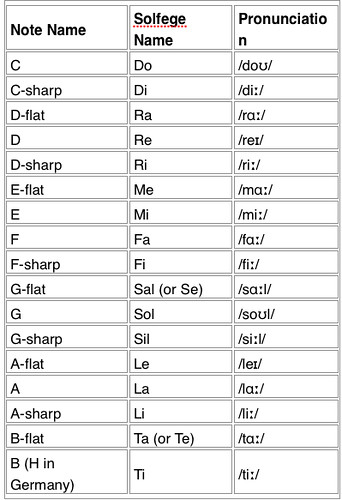

This exercise will improve your ear, help you sing more in tune and help your sight singing skills. Don’t get discouraged if it takes a good amount of practice for you to master. I will admit, this exercise is a tricky one. For instance, try jumping from “Mi” to “Le”, or “Re” to “Le” etc. Make sure you also practice finding “Le” from other points in the major scale. The interval from “Do” to “Le” is a minor 6th. Then create a chart for yourself like the one above and jump around from note to note, focusing on landing on “Le”. You will probably need to drill the exercise numerous times before you can start to hear “Le” without the help of the piano. If not, just use the video tutorial in this article. If you can play it for yourself on the piano, that’s great. Practice this vocal exercise in all twelve keys.

The reason that we use solfege and not just note names is because we want to describe how. If you’re in the key of C, then C is ‘do’. If you’re in the key of A, then A is ‘do’. In movable ‘do’ solfege, whatever key we are in, that note is ‘do’. Check out this video tutorial on the chromatic scale. Solfege is a technique of naming the notes in a way that describes their function.

It all depends on the context- just as Db and C# are the same note, so are “Le” and “Si”. So this exercise for “Le” is also an exercise for hearing “Si”- they are one and the same.

transposable to any key and understand the relationships of one interval to another. I have personally found 'Movable Do' much more effective because you can use Do Fa-Me, etc. My guess is that the page you referenced is just an error on his part, but it's possible that he's decided to change his recommended pronunciation, though I'd be surprised if that were the case as he's been using chromatic notation himself for decades (since 1960's I think.The solfege syllables for the descending scale are Do- Ti- Te- La- Le- Sol- Se- Fa- Mi- Me- Re- Ra- Do By 'Chromatic Solfege', I assume you are talking about 'Fixed Do'. (Note to Ray about my use of ge instead of ga - I'm going by Brennink's printed book on chromatic notation in which he refers to A#/Bb as gé and gives the pronunciation "gay" which in my head has become ge without the accent. Thus C#/Db D#/Eb F#/Gb G#/Ab A#/Bb become ba pa ke vi ge respectively. So with chromatic notation the need for #/b accidentals is eliminated (along with key signatures and clefs,) so it is very appropriate to give the 5 "black key" notes their own proper names. Even notating the simplest 12-tone pieces is very unintuitive with this notation system. The #/b accidentals are a kind of hack onto this old system which can use to change the keys of our 7 note scales but become a real mess when dealing with music which changes key a lot, or uses scales with more than 7 notes. In traditional notation the solfege name for C#/Db for example, can be named with two methods:ġ) do "sharp" or re "flat" (where the English word for "sharp" or "flat" is replaced by the equivalent in whatever language you're speaking.)Ģ) di or ra where the vowel sound for do has been changed to di to reflect that the note has been made sharp, or the vowel sound for re has been changed to ra to show that it's flat.īoth of these examples reflect the fact that traditional notation predates our 12 chromatic notes and was truly designed for 7 note scales only. The only difference between the chromatic notation solfege names and the traditional solfege names is on the 5 "black key" notes which require accidentals (#/b) in traditional notation.


 0 kommentar(er)
0 kommentar(er)
